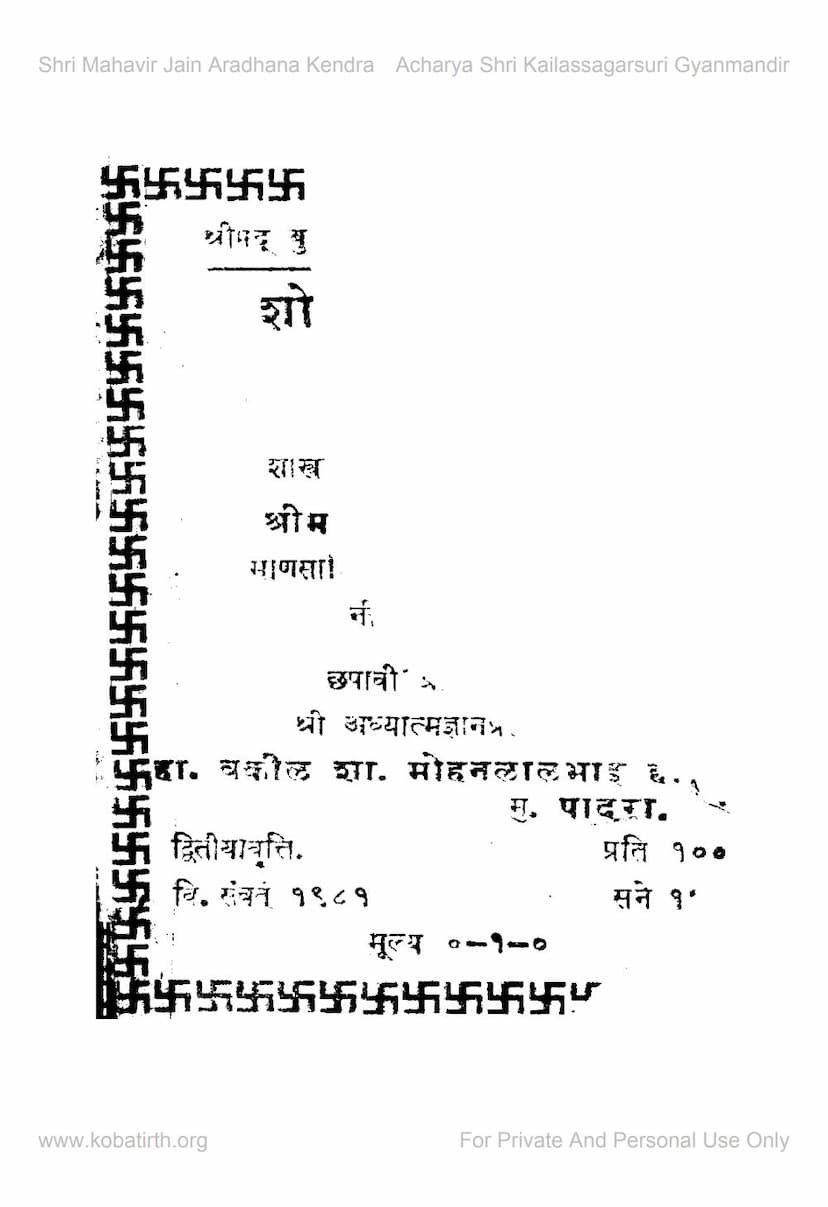Shok Vinashak Granth
Added to library: September 2, 2025

Summary
Here is a comprehensive summary of the Jain text "Shok Vinashak Granth" by Buddhisagar, based on the provided pages:
Book Title: Shok Vinashak Granth (Grief Destroyer Book) Author: Buddhisagar (likely a Muni or Acharya) Publisher: Adhyatma Gyan Prasarak Mandal Purpose: To alleviate sorrow and grief, particularly related to death and loss, by providing Jain philosophical and spiritual guidance.
Overview:
The "Shok Vinashak Granth" is a Jain text authored by Buddhisagar, published by Adhyatma Gyan Prasarak Mandal. This book is a guide designed to help individuals overcome sorrow, especially in the face of death and worldly attachments. It draws heavily on Jain scriptures, teachings, and the principles of detachment (vairagya) and the nature of the soul's journey.
Key Themes and Content:
-
Addressing Grief: The primary aim of the book is to provide solace and a framework for understanding and overcoming grief. It emphasizes that sorrow arises from attachment to worldly possessions, relationships, and the illusion of permanence in a transient world.
-
The Transient Nature of Life and the World: The text repeatedly stresses the impermanence of all worldly things, including relationships, wealth, and the physical body. It uses analogies like a drama where actors play different roles, or a dream, to illustrate that connections in this life are temporary and driven by karma.
-
The Soul and Karma: A core Jain concept explained is that the soul (atma) is eternal, but it cycles through various life forms (8.4 million species) due to the bondage of karma. Karma is presented as the true cause of suffering and the reason for rebirth and death.
-
Rejection of Attachment: The book strongly advises against excessive attachment (moha) to loved ones, wealth, and material possessions. It argues that such attachments are the root cause of grief when loss occurs. The author asserts that in reality, no one truly belongs to anyone; all are connected by the vast cycle of karma.
-
The Inevitability of Death: The text underscores that death is a natural and inevitable part of existence for all living beings. It uses examples from Jain history and scripture, such as the story of Sagar Chakravarti and his sons, to illustrate this point and the futility of excessive mourning.
-
The Importance of Righteous Conduct (Dharma): The book advocates for the practice of Jain Dharma as the only means to overcome suffering and attain liberation (moksha). It highlights the rarity of the human birth and the preciousness of the opportunity to practice Dharma in this life.
-
Guidance on Death Rituals and Beliefs:
- No Afterlife Judgment by Yama: The text refutes the common belief in a "Yama" (Lord of Death) who judges souls. Instead, it emphasizes that souls directly experience the consequences of their own karma.
- The Role of Lèśyā (Aura): It explains that the state of a soul's aura (lèśyā) at the time of death significantly influences its rebirth. Good lèsyā leads to higher realms, while bad lèsyā leads to lower realms.
- Critique of Superstitious Rituals: The book discourages many traditional rituals performed after death, such as certain mourning ceremonies ("sajiyāṁ"), elaborate feasts for relatives ("nātvar"), and shaving the head. These are seen as rooted in attachment and ignorance, contributing to financial strain and not leading to spiritual benefit.
- The Significance of the Navkar Mantra: It highlights the importance of remembering the Navkar Mantra during the dying moments to aid in a peaceful passing and positive rebirth.
- Proper Funeral Practices: The text suggests cremation over burial to prevent the spread of disease and the generation of unintended harm to micro-organisms.
-
The True Meaning of "Mine": The author questions the concept of ownership, stating that ultimately, nothing truly belongs to us. We are merely temporary custodians or carriers of karma.
-
Critique of External Reliance: The book refutes the idea of seeking solace or salvation from external deities or rituals that are not aligned with pure Jain philosophy. It stresses self-reliance in spiritual practice.
-
The Nature of Happiness and Suffering: True happiness (sukha) is internal, residing in the soul. External factors like wealth, family, or power cannot provide lasting happiness; they are fleeting and the source of attachment and eventual sorrow. Suffering (duhkha) is primarily caused by ignorance and attachment, amplified by karmic consequences.
-
The Path to Liberation: The ultimate goal is liberation (moksha), which is achieved by eradicating karma through practices like equanimity, non-attachment, right faith, right knowledge, and right conduct, as taught by the Tirthankaras.
Context of Publication:
The preface mentions that the book was originally written in 1959 (V.S.) to console a grieving father, Shri Keshavlal Lalluchand, who lost his son Nemichandra. The book's popularity led to a second edition. It also highlights the contributions of individuals who supported the publication, like Seth Mulchand Ramchandra and Seth Vavalal Chhaganlal.
Dedication:
The book is dedicated to Shri Hirachandbhai Sanjanji of Ahmedabad, recognizing his devotion, ethical conduct, and contribution to Jain community life.
Overall Message:
"Shok Vinashak Granth" serves as a spiritual guide for Jains, urging them to transcend worldly sorrow by understanding the true nature of reality, the soul, and karma. It encourages a life of detachment, virtue, and devotion to the principles of Jainism to achieve ultimate peace and liberation. The book aims to dispel misconceptions about death and afterlife rituals, promoting practices that lead to spiritual advancement rather than mere social custom.